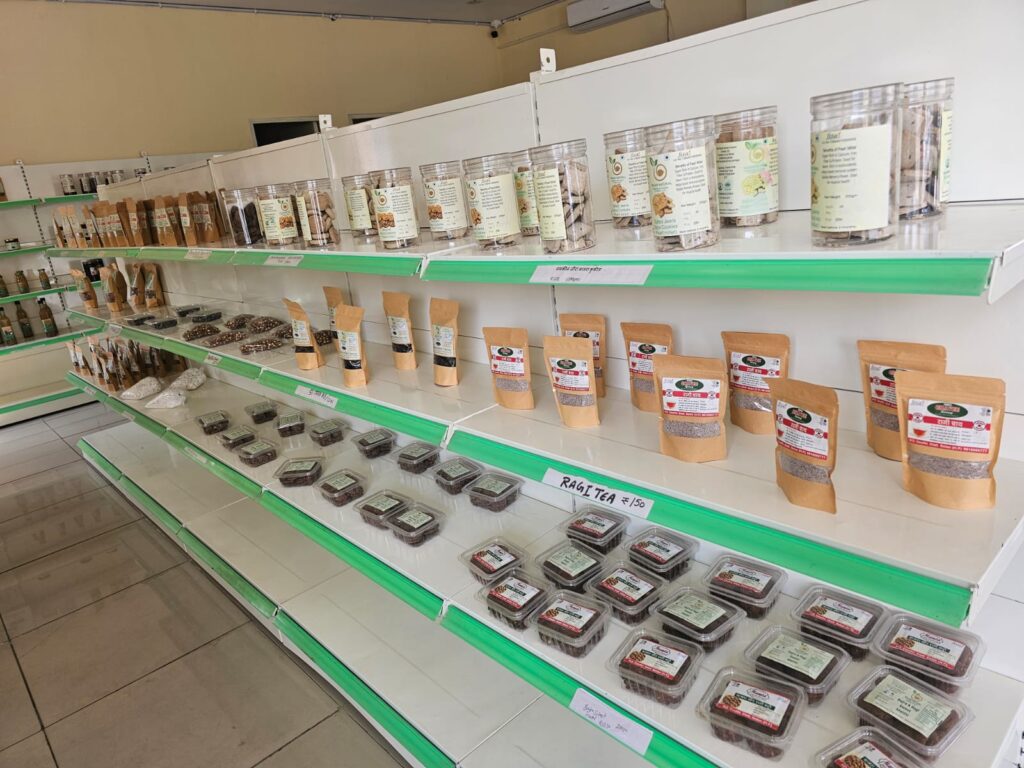Strengthening Farmer Producer Companies Networks – Market Linkage and Processing Capabilities
As an advocate for strengthening Farmer Producer Companies (FPCs), my recent journey took me from Nauni to Pacchad, a beautiful yet challenging terrain where the vision of empowering small-scale farmers is taking shape. My primary objective was to initiate discussions on establishing a strategic network between PNFPC (Pacchad Natural Farmer Producer Company) and a Delhi based social enterprise JHPL (JaivikHaat Pvt. Ltd.) www.jaivikhaat.com. Ensuring that FPCs gain stable market access in the metropolitan city and secure long-term business opportunities is essential for trading surplus produce from various regions of Himacha Pradesh. This also generates valuable data on net return to farmers, value chains and sustainability.
Gram Disha Trust is also a Sustainable Agricultural System (SAS) as part of the Global ACROPICS network. Workshops held between the SAS and FPCs also led towards discrete objectives for capacity building and martket linkage for Natural Farmers of the FPCs.
A Vision for FPC Market Access in Delhi
One of the biggest challenges that Farmer Producer Companies face is finding a consistent and reliable market. Many small farmers grow high-quality natural produce, but due to lack of direct buyers and dependence on middlemen, they do not receive fair prices for their hard work. By exploring the potential of a direct supply chain between PNFPC and JHPL, my goal was to initiate a structured and sustainable market access in Delhi.
JHPL, an established retailer in the capital city which has worked for over 16 years to connect farmers to markets. JHPL is always on the lookout for supporting farmers and FPCs with ethically sourced and high-quality farm produce for consumers. By connecting them with PNFPC, we aim to ensure better revenues for farmers while giving consumers access to fresh, natural, and CETARA-NF certified produce straight from Himachal Pradesh. JHPL upholds the principles of traceability and transparency. It does so by voluntarily declaring the source of produce to the consumers and also porviding the net return of the consumer rupee to the farmers. These discussions will soon be presented in a formal meeting with GDT in the first week of March 2025 to develop a concrete plan.
Journey to Pacchad and the Ground Reality
My travels from Nauni to Pacchad were driven by the excitement of exploring the possibilities of such a partnership. The journey itself was a mix of anticipation and reflection, as I knew that building such networks requires patience, strong negotiation, and alignment of interests between multiple stakeholders. Once in Pacchad, I met with PNFPC members, discussing their expectations, current supply chain issues, and how this connection with JHPL could be beneficial for them.

The discussions revolved around setting clear supply chain expectations, maintaining product quality, pricing negotiations, and logistics planning. However, before proceeding further, a formal meeting with GDT in the first week of March will help finalize the next steps for a consistent and uninterrupted supply of raw and processed farm produce.
Assisting SNFPC in Establishing a Processing Unit
While my focus remained on discussions regarding connecting PNFPC with JHPL, Parallel discussions were held with SNFPC, which is seeking GDT’s support in setting up a processing unit aimed at value addition and reducing post-harvest losses. Processing agricultural products enhances their marketability, extends shelf life, and provides higher returns for farmers. The importance of value addition in agricultural products cannot be overstated. Many farm products, if not processed properly, suffer from short shelf life and market volatility. By exploring processing solutions, SNFPC aim to enhance the value of farm produce while reducing spoilage and increasing market demand.

Key Products for Processing – Ginger, Garlic, and Beetroot Powder
One of the key discussions at SNFPC was the processing of ginger, garlic, and beetroot into high-value products. These include:
Ginger and Garlic Powder: Essential kitchen ingredients with a long shelf life and great market demand in both retail and bulk markets.
Beetroot Powder: A nutrient-dense product that not only extends the usability of fresh beetroot but also opens doors for innovative consumer products.
Instant Beetroot Juice: By further processing beetroot powder, we envision creating a convenient and nutritious instant beetroot juice for health-conscious consumers. This product would be a rich source of antioxidants, minerals, and vitamins, catering to urban consumers looking for easy-to-use natural health supplements.
The Role of GDT in Setting Up the Processing Unit
With GDT’s technical expertise, infrastructure support, and training programs, SNFPC members could be equipped with the skills needed to operate the processing unit efficiently. GDT’s involvement could ensure that the FPC members understand the best practices in food processing, hygiene, packaging, and branding, ultimately leading to a product that could compete in larger markets. However, these details will be further refined during the scheduled meeting in the first week of March.
Creating a Sustainable Model for the Future
The combined discussions around creating a market link between PNFPC and JHPL and setting up a processing unit for SNFPC mark an important step towards a sustainable and profitable future for these FPCs. By focusing on:
- Market access and supply chain management,
- Value addition through processing, and
- Training and infrastructure development, we are laying the groundwork for economic stability and growth for small farmers in the region.
As I left Pacchad, I felt a sense of anticipation knowing that these initiatives, once formally discussed and agreed upon in the upcoming meeting with GDT, will not only uplift farmers financially but also empower them with knowledge and skills. The road ahead is long, but with persistence and collaboration, we can ensure that Himachal Pradesh’s farmers find a lasting and profitable place in the urban market.
This journey is just the beginning. More collaborations, innovations, and farmer-centric solutions will be explored in the first week of March as we work towards a stronger, more connected agricultural ecosystem.


